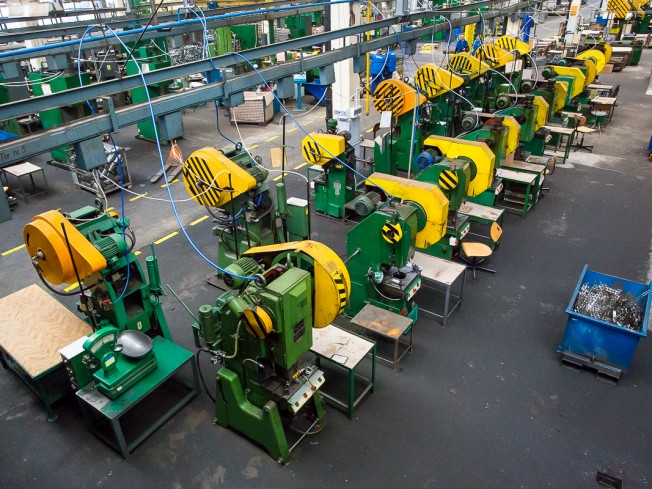THE ROUTE:
● Central Industrial Region Auxiliary Plant (currently: PZL Sędziszów S.A. Filter Plant)
Distance between the sites
Total length of the Route: 1.6 km
On foot – total walking time: 20 min.
By bike – total riding time: 6 min.
The production in the Filter Plant began in 1939. The plant was built within several months, during which the assembly hall, the mechanical department with a foundry and a welding shop, as well as the warehouse, the woodworking shop and the utility buildings were constructed. Its products included mainly metal components, e.g. for the Rzeszów and Poznań branches of the H. Cegielski Plant, agricultural machinery (especially threshers), metal fittings for carts, components of cars, planes and machine tools, as well as car spanners. The Central Industrial Region Auxiliary Plant also offered repair services of distillery, mill, sawmill, etc., equipment. Moreover, orders were executed for portable barracks, military bunk beds, various carts, artillery ammunition boxes and other military equipment. Initially, the plant employed about 30 people, but soon there were as many as 447 employees.
Jan Kroczka, an organizer of the plant and its director from 1938 to 1950, recorded in the Plant Chronicle: “The period after 1940 was the hardest for the company. Already during the hostilities in 1939, a lot of raw materials and tools had been stolen. Apart from that, an attempt to launch production without adequate finance or orders did not look promising.”
“A major problem was that the newly-built plant was not connected to the power grid, so all the machine tools, such as lathes, the eccentric press and the forging shop, had to be hand-powered. This meant that each machine tool was operated by two workers: one of them kept pulling at a crank to rotate a large pulley, which, through another belt, rotated the machine tool’s pulley, so that the other worker could actually operate the tool. Such a ‘system’ was in place from 1940 to 1941.” [From: Filters & Service – No. 4, September 2014, p. 14]
In 1942, the facility was taken over by a German company from Hamburg. Its name was changed to Drezenenbau, and the production of rail trolleys, either hand-powered or combustion-engine ones, began. In 1943, 50 hand-powered rail trolleys, on average, and about 30 combustion-engine ones were made here per month, which gave employment for 150 people. [65 lat Wytwórni Filtrów (65 Years of the Filter Plant)]
This is how the following years were described in the Plant Chronicle by Jan Kroczka: “In early July 1944, when the Soviet armies were moving quickly across the Polish soil, the German authorities decided to evacuate the plant. In great haste, they managed to dispatch to Germany two carloads of the most valuable technical equipment […]. In fear of the front-line fighting in Sędziszów, I buried several machine tools, as well as some tools and raw materials to prevent them from destruction, should the plant catch fire.” He also recollects the last days of September 1944: “The plant made a sorry sight. All the brick halls (except from the foundry), as well as the machine tools and equipment left in the halls – including the machine tools previously buried – were burnt down. Total losses were estimated at 65,451 Polish zlotys (according to a 1939 evaluation), which accounted for about 50 per cent of the value of the plant.” [Świat Filtrów (The Filter World), No. 5, December 2014 – p. 14]
The retreating Nazi German troops destroyed and burnt down most of the plant production halls. After the war, the Filter Plant was rebuilt, but its production profile was narrowed down. The production of threshers and the agricultural repair services were launched. In 1950, at the moment of its nationalization, the plant employed 66 manual and 6 office workers. Its main products were radial oil seals (in Poland, they were manufactured only in the plant in Sędziszów Małopolski), hospital beds and operating theatre tables. In 1955, the production began of the first air filter (for Star trucks), which was the starting point of a new specialization. At present, the PZL Sędziszów S.A. Filter Plant is operating on the former premises of the Central Industrial Region Auxiliary Plant.
Today, the PZL Sędziszów S.A. Filter Plant is a world leader as regards filter products. It offers fuel, air and oil filters for all types of engines and equipment, including air filtration equipment, process media and cooling agents. The company has distinguished itself through its many-year-long experience and innovative approach: research is conducted in the plant on developing filtration solutions, in an attempt to set new growth directions for this industry. Since August 2012, 85 per cent of the plant’s initial capital has been held by the Unmot Express company, one of the leading distributors of fuels, oils and propellants.
Tours of the production hall of the PZL Sędziszów Filter Plant are available, subject to advance arrangement. Under the supervision of a well-qualified employee, we may watch the process of filter production and learn about the filter assembly principles.
After a tour of the plant, we head for the roundabout and the intersection with Armii Krajowej street, and then – via Armi Krajowej, Wesoła and Kolejowa streets – we reach the bus and railway stations.







